Housing market remains weak, but outlook is improving and Wales will outperform the rest of the UK in the next five years, with price growth of 21.4%
Prices in Wales have fallen in 2023, as rising mortgage rates temper demand. Transactions have also fallen below 2017-2019 average levels, while rents are rising at record pace. We expect continued weakness in the sales market in 2024, as interest rates remain at or near peak. Beyond this, affordability constraints will ease and price growth will return.
Both new homes completions and new planning consents have fallen in 2023, meaning the outlook for new homes delivery has weakened.
Prices and activity fall, but recovery is in sight
House prices have fallen, and will fall further in 2024, but will recover from 2025 onwards. Mortgage rates have risen sharply, constraining affordability and decreasing demand, which sits well below supply according to the RICS. This has led to price falls of -5.5% in the year to September, according to Nationwide. We expect prices to fall by a further -2.0% in 2024, as interest rates remain near peak and the full impact of past rate rises filters through. But interest rates are expected to fall from the middle of 2024, improving affordability and increasing demand. This will allow price growth from 2025 to 2028 of 23.9%.
House prices in Wales will outperform the UK average over the next five years. Affordability in Wales is less stretched than elsewhere, meaning the impact of rising mortgage rates is less severe. Forecast price growth of 21.4% in Wales in the next five years is the strongest of any part of the UK.
Price falls have not been equal across Wales. The strongest growth in the year to July was seen in the southeast, for example in Blaenau Gwent (+7.6%), while the largest falls were in the northwest, such as the Isle of Anglesey (-5.5%), according to the Land Registry. This lags the Nationwide index and therefore continues to show growth in some markets. It is likely that this index will show further falls in the future.
Transaction activity has been weak in 2023. The first nine months of the year saw -18% fewer transactions than the pre-pandemic average. We expect activity to remain low into 2024, before falling mortgage rates gradually encourage more buyers into the market.
Rental growth on all tenancies in the year to September has been stronger in Wales than any other area of the UK, according to the ONS, at 6.9%. Rents for new lets have increased by 10.4%, according to Zoopla. Demand for rental properties still significantly exceeds supply, according to the RICS survey. Many landlords have sold their properties under pressure from higher interest rates and greater regulation through the Renting Homes (Wales) Act 2016. Renting is becoming less affordable across the market, but those at the lower end are particularly struggling. LHA has been frozen since the pandemic, meaning the average LHA for two beds in Wales now covers just 2.1% of the market. Pressure in the rental market will incentivise buying activity from first-time buyers (FTBs), while home movers are likely to be less active.
Delivery falls as higher costs impact viability
New homes completions annually fell by -7% in the year to September, according to EPCs, and remain -6% below the 2017–19 average.
Starts and consents have both fallen much more significantly. A 33% increase in construction costs for housebuilders since the pandemic (BCIS), combined with higher interest rates and a weaker sales market make viability very challenging. Starts were down -18% in the year to June (StatsWales), while consents were down -31% in the year to September (HBF and Glenigan). This shrinking pipeline of new housing in Wales will translate into lower completions in the future.
The extension of the Help to Buy (HtB) Scheme will give new homes a competitive advantage in Wales, which may help improve sales rates and make development more viable. Changes to the price cap have meant use of the scheme has fallen in recent years, supporting 81% fewer sales in the year to June 2023 than the 2017–19 average. Completions would be expected to rise again under the new, more flexible scheme, but for now, buyers using HtB remain constrained by high interest rates.
Affordable housing delivery fell -5% short of need in 2022/23, but rose by 26% year-on-year, for the second strongest year of delivery in the last decade. Delivery in 2024 is expected to remain relatively high, but there remains a backlog of under-delivery built up over the last decade.

Credit: Getty Images/iStockphoto
Demand in the sales market has remained very weak for more than a year, while supply has been relatively stable, although has weakened since June 2023. Most surveyors reported falling demand in the three months to September, with a net balance of -48, while a smaller majority reported falling supply, at -15.
Demand has been negative since mid-2022 but fell most sharply in October 2022, when the mini-budget caused a sharp rise in the cost of debt and has not yet recovered. The market will likely remain subdued over the coming months, as interest rates remain at peak into 2024, resulting in a continued decline in house prices.
House prices have fallen by -5.5% in the last year in Wales, according to Nationwide, slightly more than the average UK price fall. Q3 2023 saw a -1.6% fall in values, lower than the -2.7% seen in Q4 2022 following the mini-budget.
The net balance of opinion of surveyors reporting price growth has fallen to -41 in October and has averaged -40 in the last six months, according to the RICS survey, again indicating falling prices.
Surveyors’ expectations for the next three months remain negative, at a net balance of -41, although less so than between June and September. It is likely that price falls will continue.
Transaction activity has fallen to -20% below the pre-pandemic average in Q3 2023. Activity has remained low since late 2022, with the first nine months of 2023 all seeing transactions at least -10% below the 2017-19 average.
The shortfall in transactions compared to average has become more significant since April, as sticky inflation and the ‘higher for longer’ narrative surrounding interest rates caused mortgage rates to rise to a new peak.
We expect transaction activity to remain below average over the rest of 2023 and 2024 as interest rates continue to weigh on demand. But activity will return from 2025 as interest rates fall back and housing becomes more affordable.
Completions fell by -7% in the last year according to new build EPC data, and starts and consents have fallen further, threatening the future delivery of new homes.
There have been -18% fewer starts than completions in the nine months to June 2023, according to StatsWales. Viability challenges surrounding the cost of debt, construction costs, and slower sales rates mean developers are starting on fewer sites.
Consents have fallen even further than starts – by -31% in the year to September 2023, according to the HBF and Glenigan. This means the delivery of new homes is only likely to fall in the future.
Affordable delivery rose by 26% in the year to March 2023, but still failed to meet the latest affordable housing need figure, falling -5% short. There were modest rises in delivery by registered social landlords (RSL), but the largest growth in new supply came from non-RSL provision.
The year to March 2023 was still the second strongest year of delivery in the last decade, suggesting historic delivery of affordable housing has been insufficient. Future projections suggest that completions will fall further from target in 2023/24. Concerns around planning and viability mean Housing Associations are struggling to develop themselves, spending grant funding on acquiring newly built stock from housebuilders.
Housing delivery exceeded Welsh Government housing need in three of the four regions of Wales in the year to Q3 2023. Total completions exceeded need by 6%, according to new build EPC data. But South West Wales is falling short of its housing need by 13%.
Delivery has fallen in all but one region over the last year, suggesting that meeting need may become more difficult in future.
Most Local Planning Authorities (LPA) in Wales have begun the process of adopting a second Local Development Plan (LDP). In 2023, Flintshire became the penultimate LPA to adopt a first LDP, leaving Wrexham as the only outstanding authority with a Judicial Review ongoing after Members voted not to adopt its first LDP.
Neath Port Talbot and Torfaen recently decided to restart the LDP preparation process and have recently completed Calls for Sites. Overall, there remains a lot of activity across South Wales with many LPAs either looking forward to, or recently having consulted upon, Preferred Strategies.
Use of Help to Buy in Wales has fallen, with annual sales under the scheme falling -58% in the year to June 2023. Just 4.5% of new build purchases in the year to June were made through the scheme, down from 9% a year earlier and 25% at peak. The scheme had applied to FTBs only, with a reduced price cap of £250,000 since May 2021, resulting in falling take-up.
It had been due to close to applicants on 31st March 2023 but was extended to March 2025, and applies to all buyers with a higher price cap of £300,000. This is a significant departure from policy in England, where the scheme has now ended. The scheme enables buyers to take on more debt and purchase more expensive homes than they would otherwise be able to afford. This should give new build homes in Wales a competitive advantage and may help support sales rates over the next two years, improving viability and enabling stronger delivery of new homes.
Rents on new lets grew by 10.4% in the year to September, below the July 2022 peak of 12.2% but well above the long-term average, according to Zoopla. Rental growth for all tenancies (including renewals and existing leases) was 6.9% in the same period, according to the ONS, the highest figure on record and the highest annual reading to September of any area of the UK.
Rents have grown by 33% since the pandemic (Zoopla), becoming increasingly unaffordable, particularly for those on lower incomes and housing benefits, for whom Local Housing Allowance has been frozen since the pandemic.
Many landlords are selling their properties due to the higher cost of debt, exacerbating an existing supply-demand imbalance and driving strong rental growth. Rents are likely to continue rising in the coming months.
